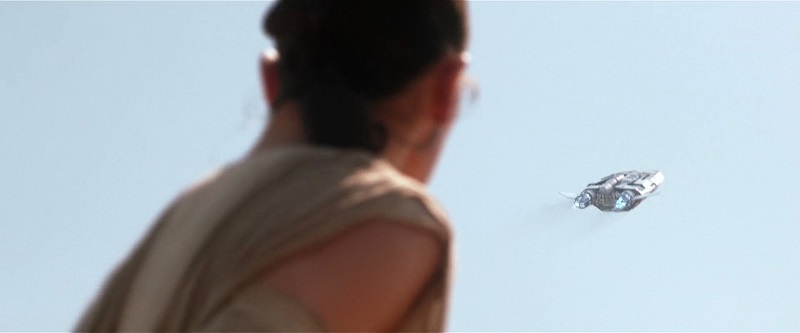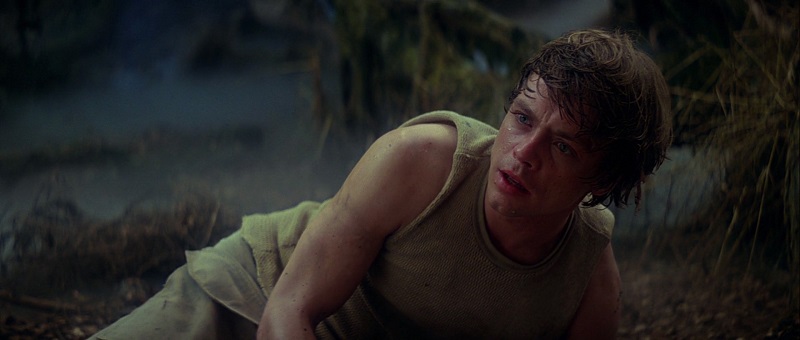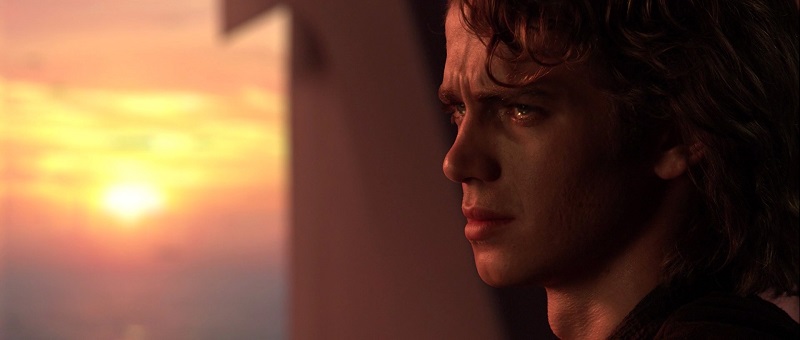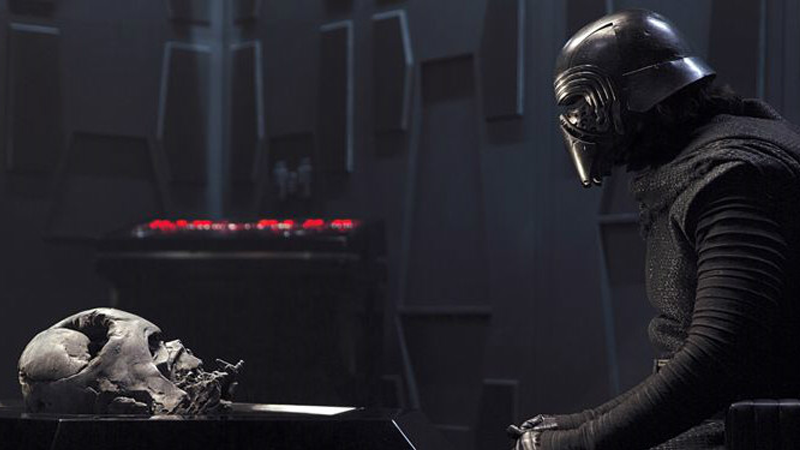
Throughout his Star Wars films, George Lucas keeps returning to the idea that dwelling on the possibilities of the future is dangerous, and that instead one should try to live in the present moment. In The Force Awakens, JJ Abrams and Lawrence Kasdan approach this idea from the opposite direction, which may give us some clues as to where Rey’s journey, in particular, might be going in Episodes VIII and IX.
The original trilogy
In The Empire Strikes Back, Yoda is at first reluctant to train Luke Skywalker, because “all his life has he looked away – to the future, to the horizon. Never, his mind on where he was! What he was doing!” Later in the film, while meditating, Luke sees a vision of the future: his friends Han and Leia in terrible danger. Yoda instructs him not to act on these images, and warns that “always in motion is the future”, but Luke defies him. The results are disastrous. Luke is unable to help his friends, who ultimately rescue themselves, and instead finds himself in a confrontation with Darth Vader that he isn’t ready for. The friends he goes to save end up having to save him.
In Return of the Jedi, it is Emperor Palpatine who fails due to his preoccupation with the future, this time fatally so. He confidently asserts that “everything is proceeding as I have foreseen”, constructing his plans around his own foresight. He even says, of Luke, “his compassion for you [Vader] will be his undoing,” and that it is Luke’s “destiny” to join the dark side. But Palpatine misses the truth that is right in front of him – the conflict in Vader. Luke sees this clearly, and in the end, it is Vader’s compassion for Luke that proves to be Palpatine’s undoing.

One message we are to take from both of these examples is clear – making your decisions based on a vision or prediction of future events is unwise and can lead to disaster. However, it is in the prequel trilogy that Lucas really takes the time to develop this theme.
The prequel trilogy
By their very nature as prequels, Episodes I-III are preoccupied with the future, as they build towards a story we are already familiar with. These films are full of prophecies, portents of doom, and inversions of our expectations based on our knowledge of Episodes IV-VI. For instance, that the Jedi end up fighting on the same side as clone troopers and Star Destroyers is a twist that only works if you know that those symbols will come to define the future Empire. There are also in-jokes that only work if you have knowledge of later events – for example, Obi-Wan’s line to Anakin in Attack of the Clones: “Why do I get the feeling you’re going to be the death of me?”
Visually, the films also look to the future, as we see starship and location designs taking on familiar aesthetics, becoming more angular, utilitarian and battered as the galaxy slips further into war and the Republic becomes the Empire. But it is through the trilogy’s characters that the danger of preoccupation with the future is truly explored.
The first lines of any real consequence in The Phantom Menace are between Obi-Wan and his master, Qui-Gon:
Obi-Wan: I have a bad feeling about this.
Qui-Gon: I don’t sense anything.
Obi-Wan: It’s not about the mission, master. It’s something … elsewhere. Elusive.
Qui-Gon: Don’t centre on your anxieties, Obi-Wan. Keep your concentration here and now, where it belongs.
Obi-Wan: But Master Yoda said I should be mindful of the future.
Qui-Gon: But not at the expense of the moment. Be mindful of the Living Force, young Padawan.
Given our knowledge of later events, we might assume from this that it is Obi-Wan who has the real insight, and that Qui-Gon is being naïve. However, we also know that in ESB, Yoda warns of the dangers of looking into the future. Has something in Yoda’s outlook changed?
TPM introduces the idea of the Jedi Prophecy, which predicts that Anakin Skywalker is destined to destroy the Sith and restore balance to the Force. It is ironic that it is Qui-Gon – who is more interested in the Living Force, an appreciation for the beings around him in the present –who discovers Anakin. But Qui-Gon’s faith in the prophecy does not come from a vision of the future; instead he is led by his belief that the will of the Force itself has led him to Anakin, and follows this instinctively.
As we move into Attack of the Clones, we see the Jedi Council’s initial uncertainty about Anakin has become complacency. The dark side has been growing in strength and clouding their vision. Early in the film, Yoda attempts, and fails, to look into the future while Darth Sidious himself sits across the table from him. The Council, it seems, have put their faith in Anakin as the one hope to restore balance. When Obi-Wan warns that Anakin has become arrogant and “has much to learn”, Mace Windu dismisses his concerns, reminding him of the Prophecy. By the time Mace starts to lose faith in Anakin in Revenge of the Sith, it is too late. The Jedi have ignored the truth staring them in the face – Anakin’s inner turmoil, his repressed anger, and his desperate fear of losing those he cares about.
The Jedi faith in the Prophecy, and their failure to see the truth of Anakin’s conflict, directly mirrors Palpatine’s fall in RotJ. Perhaps the Yoda of ESB learned from this mistake. But Anakin’s own fall is perhaps the clearest example of this theme in the whole saga.

In Revenge of the Sith, Anakin has a vision of his wife, Padmé, dying in childbirth. Yoda warns him that “careful you must be when sensing the future, Anakin – the fear of loss is the path to the dark side.” He advises Anakin that he needs to prepare himself to let go of everything he fears to lose, but Anakin is unable to do so. Haunted by his visions, he instead turns to Palpatine’s promise of the power to save people from death, and sides with the Sith Lord and against the Jedi. As he falls deeper into the dark side and his hunger for power and control grows, he turns Padmé away from him, and his fall ultimately leads to her death. By dwelling on the future and going to extreme lengths to prevent his visions from coming true, he causes the very events he has been trying to avoid.
George Lucas once described himself as a “Buddhist Methodist”, and we can see some of this philosophy in Buddhism. The Buddha is quoted as saying:
“They do not mourn for the past,
They do not yearn for the future,
They live on the present”
A remarkably similar quote is used as the moral at the beginning of the Clone Wars episode “Voyage of Temptation”:
“Fear not for the future,
weep not for the past”
The key change to the quote is the emphasis on fearing the future rather than yearning for it, which is relevant to Luke’s vision and particularly Anakin’s fall. Fear, as Yoda tells us in TPM, is “the path to the dark side”, and by its nature fear is the anticipation of future pain or distress.
This philosophy has found its way into modern psychology and therapy through the technique known as “mindfulness”, which has its origins in Buddhist meditation. In broad terms, mindfulness meditation teaches a person to become aware of, and to experience, their thoughts, feelings and the world around them in the present moment.
Both Luke and Anakin fail when they allow their visions of the future to affect their decisions, and the Jedi Council and Palpatine allow their preoccupation with the future to cloud the truth that is staring them in the face. However, the quote from the Buddha also mentions “mourning for the past.” That is where The Force Awakens comes in.
The Force Awakens and the sequel trilogy
TFA is a film with a fundamental focus on the history of Star Wars. It is the first film helmed by a director who grew up with the series, and every artistic decision is made with the intention of recapturing the Star Wars JJ Abrams remembers from his childhood. We don’t see radically new ideas and designs – instead there are familiar-looking X-wings, TIE fighters and Star Destroyers, and the Death Star-like Starkiller Base. There are moments in the film that only make sense if you have strong memories of the original trilogy – for example, there is no need for the camera to spend as long as it does focusing on the holochess table in the Millennium Falcon, other than to induce a sense of nostalgia. However, there is something deeper underpinning this: TFA is a film about people stuck in the past, who need to “awaken” from this and move on with their lives.
By its very nature, the First Order is obsessed with the past. Its goal is to restore the power of the Empire, and it borrows the Empire’s iconography – stormtroopers, TIE fighters, and Star Destroyers. We might infer that this is to tap into the galaxy’s collective memories of the Empire and inspire fear and awe. General Leia’s Resistance, meanwhile, tries to recapture the spirit of the Rebellion, even using the Rebel Alliance’s logo as opposed to that of the New Republic.
Our three heroes from the original trilogy are all, when we meet them again, trapped by their guilt over past mistakes. Following their son’s fall to the dark side, Han and Leia both revert to “the only thing I was ever good at” – Han a smuggler, Leia a general. They go back to their comfort zones. Han’s character journey in TFA is to awaken from this state and confront the truth about his son. Luke, meanwhile, tortured by guilt over his failure to keep Ben Solo on the light side of the Force, has gone on a spiritual quest to find the first, ancient Jedi Temple. He too has buried himself in the past to find peace, but must be awakened from this for the galaxy to survive.

Then there is Kylo Ren himself. Obsessed with his bloodline and living up to the legacy of his grandfather, Darth Vader, Ren wears a mask despite having no need for one. He is also, we learn from The Visual Dictionary and Star Wars Rebels, a student of history. His unique lightsaber is based on a design found in the ancient Sith temple on Malachor. With his knowledge of the history of the Empire’s origins, he suggests a clone army may make a more effective force than General Hux’s more radical approach to stormtrooper training.
And finally, we have our hero, Rey. She grows up on Jakku surrounded by relics from history – living in the remains of an AT-AT walker, scavenging for junk in the wreckage of Imperial Star Destroyers, and wearing a rebel pilot’s helmet for the sheer fun of it. But Rey is also trapped by her own past. The only reason she stays on Jakku is in the vanishing hope that her family, who left her there, will one day return. When Maz Kanata tells her that this will not happen, but that Rey’s belonging “lies ahead” instead of behind her, Rey initially refuses to accept this truth and runs away. It is only once the Force truly awakens in her and shows her the way forward that she accepts her new path, and puts her old life behind her.
It appears that, in an inversion of the first two trilogies, the sequel trilogy will be more interested in showing the danger of being stuck in the past rather than dwelling on the future. But this is still in keeping with Lucas’s philosophy. Living in the future and in the past are both dangerous distractions; enlightenment is found through living in the moment.
Based on this, can we predict where Rey’s story will go next? In Lucas’s trilogies, both Luke and Anakin are tempted by visions of the future, and both fail because they let their actions be guided by them – Anakin tragically so. In the sequel trilogy, we might expect Rey to be tempted by something from her past. Perhaps Snoke or Kylo Ren will promise her that they can lead her to her family if she leaves the Jedi path; or perhaps she will learn something about her past or her family that will torture her, or wrack her with guilt, and cause her to turn away from Luke and the Jedi.
Whatever the details, I expect Rey’s journey to continue to focus on the way she learns to let go of her past, and accepts a new life and a new destiny for herself.

Excellent! Well written and very valid and illuminating points you make.
“TFA is a film about people stuck in the past, who need to “awaken” from this and move on with their lives.” Boom.
That nails it. And in a meta way, for die-hard purist fans, too. Embrace the old, but it’s time to move on and experience the new; what’s happening now-now.
This is a great article. Another way one can get stuck in the past is the desire for revenge. Perhaps Rey will be tempted by the dark side when she wants to have vengeance on those who had abandoned her on Jakku.